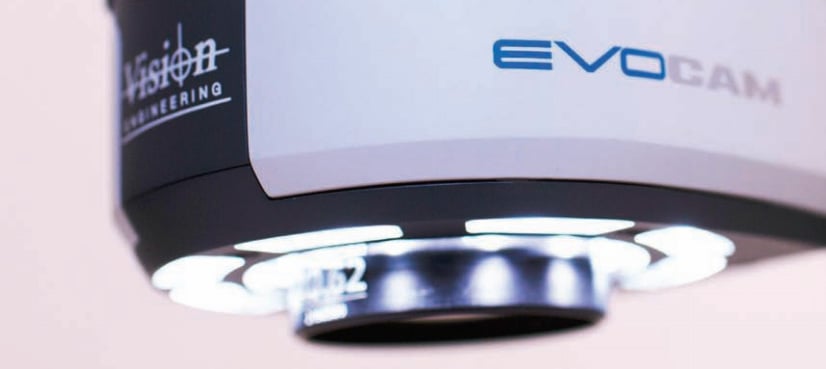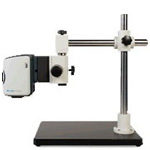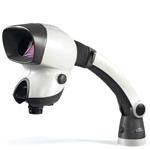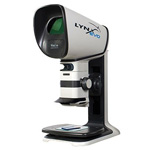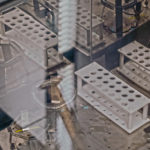Surgery and other medical procedures require precise, clean, and well maintained instruments. Dirty surgical instruments are more common than one might think. Post-cleaning inspection devices provide a critical bridge between decontamination, the sterilization processes, and final sterile outcomes.
Here we’ll cover the basics of digital microscope cameras for instrument inspection. Sub-illumination, integrated cameras, ergonomic function, and traceability are primary considerations during high-volume instrument cleaning.
Overcoming Inadequate Staffing Levels & Lackluster Quality Control
Some hospitals struggle with adequate staffing levels and quality control programs during instrument cleaning, sterilization, and inspection. The result is anything from delayed or postponed surgeries, longer procedure times, surgical site infections, and sometimes, complications or death.
“Four surgeons at the DMC said they encounter improperly cleaned, missing or incomplete sets of instruments about once a month or more. One longtime surgeon said he’s discovered old tissue and blood on surgical equipment that he regularly uses, and has used duct tape on occasion to repair broken instruments during surgeries.”
“The department’s 71 technicians make about $18 an hour and are responsible for cleaning several thousand instruments per day to exacting specifications, assembling them into sterile “case carts” and delivering them to operating rooms in a few hours.“
“Doctors are concerned because old blood and bone, even when sterilized, are biohazards that can trigger infection, septic shock and even death”
Detroit News
A surgical instrument set may contain hundreds of different pieces. A hospital may clean and throughput hundreds of instrument sets and thousands of individual components each day. Technique, procedure, equipment, training, workflow: all these factors influence consistency and “defect” rates during instrument handling and cleaning.
Related: A Day in the life of the Hospital Sterilization and Disinfectant Unit
Decontamination and Sterile Processing Areas
Sterile Processing Departments typically include four major decontamination functions; assembly and sterile processing; sterile storage; and distribution.
Post-cleaning inspection ensures that each tool is accounted for, in a state of good repair, and clean of any bioburdens. Clinical staff must also avoid contaminating the instruments after terminal sterilization.
In the decontamination area, reusable equipment, instruments, and supplies are cleaned and decontaminated by means of manual or mechanical cleaning processes and chemical disinfection. Following the cleaning process, the microscopic inspection of the instruments takes place.
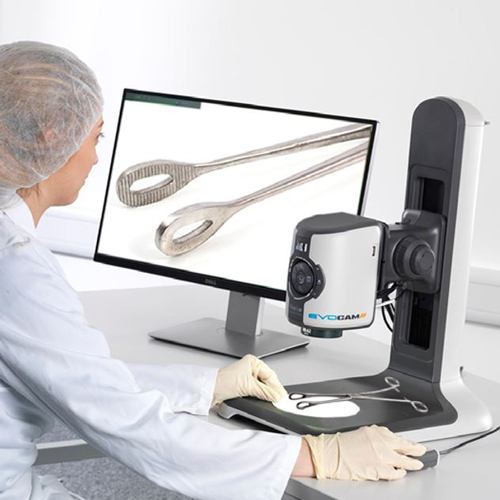
After cleaning, all instruments undergo inspection under USB microscope connected to a monitor, or a direct viewing magnifier before packaging, reuse, or storage. The importance of inspecting each instrument cannot be over-emphasized. A visual check for cleanliness and dryness should be made for all items washed, as part of the decontamination process.
Surgical Instrument Cleaning and Inspection – Best Practices
Box locks, serrations, and crevices should be critically inspected for cleanliness. Instruments with cutting edges such as scissors, rongeurs, chisels, curettes, etc., should be checked for sharpness. There should be no dull spots, chips, or dents.
Hinged instruments such as clamps and forceps should be checked for stiffness and alignment of jaws and teeth. Tips should be properly aligned, jaws should meet perfectly, and joints should move easily.
Ratchets should close easily and hold firmly. Any instruments with pins or screws should be inspected to make sure they are intact. Plated instruments should be checked to make sure there are no chips, worn spots, or sharp edges. Worn spots can rust during autoclaving. Chipped plating can trap dirt and can also damage tissue and rubber gloves when used, if not cleaned properly.
Forceps and Hemostats: A visual test would be to close the jaws lightly. If they overlap they are out of alignment and need re-aligning. If the forceps have serrated jaws they should be checked to see that they mesh fully. There should be no play in the box joint of the instrument.
Scissors: Blades should be checked for burs and they should be in good approximation all the way down the length. There should not be excessive fretting around the pivot pin which would lead to possible corrosion and breakage
Needle Holders: A needle should be clamped in the jaw and the instrument closed to ensure that the needle can not be moved or turned easily.
“If any problems are noticed during the inspection process, these instruments should be either cleaned again, or sent for repair depending on the problem observed.
“There are a number of visualization tools on the market for visual inspection of instrumentation. However, stereo inspection digital microscopes provide technicians with a 3D view of instruments and the ability to view all sides of the instrument at once, clearly and effectively. Ideal for visualizing troubled areas like box locks and jaws, which often harbor residual bioburden.“
Assistant SPS Chief at Northeast Ohio VA Health Care System.
The condition of the instrument has a significant effect on how adequately it can be cleaned. Instruments subjected to rough handling will develop scratches and surface abrasions which will trap and hold dirt. Damaged surfaces harbor dirt and bacteria, require longer cleaning cycles, and may increase risk factors for safe use and patient outcomes.
Types of Digital Microscopes & Microscope Cams
Digital microscope models vary widely in optical ability, integrated features, and task specialty. It’s in anyone’s best interest to fully explore their options and identify the camera microscope most appropriate for their task. In most cases, requesting a demo unit provides the most meaningful comparison for case-by-case use and maximum lifetime value.
While there are many different brands of digital microscopes and inspection devices, here we’ll outline some options from one our manufacturing-direct suppliers, Vision Engineering. This should help you identify the types of features and differences in cross-brand optics, features, and value-added options.
Digital Camera Microscopes for High resolution Images and Optical Magnification
EVO Cam II
Digital microscopes such as the EVO Cam II combine excellent optics and simple image capture for faster and more reliable documentation.
An high definition digital microscope with stunning image quality, that combines optical excellence with ease of use and efficient workflows. The EVO Cam II is a digital magnification microscope that makes image capture and documentation simpler, faster, and more reliable.
The Mantis Compact – Eyepieceless
Eyepiece-less optical microscopes offer superb 3D images with user benefits. All systems can be fitted with a camera, making it ideal for image capture, training, and reporting.
Mantis Compact is a low magnification visual inspection microscope, providing truly superb 3D imaging with unparalleled freedom of head movement. The compact does not include an integrated camera for image capture but is offered as a factory option.
Specifications: Mantis Compact Visual Inspection Microscope: 2 – 8x
The Mantis Elite – 25mm View | Digital Camera Microscope
By adding an HD camera, the Mantis Elite HD offers a comfortable inspection solution, providing flexibility and simplicity for any precision magnification task.
Specifications: Mantis Elite 3D Eyepieceless Microscope: 2 – 20x
Lynx EVO & Mantis – Stereo Microscope | 35 mm | Digital Camera
The Lynx EVO and Mantis systems do not require the operator to place their eyes directly in front of the binocular eyepieces.

Eyepieces are replaced by a window through which the exit pupil is projected with an exit pupil diameter up to 35mm, depending on whether the microscope is the Mantis (inspection and rework), Lynx EVO (inspection and rework) or Swift PRO (inspection and measuring) model. Operators experience less fatigue and strain making them more efficient, accurate and productive.
What’s the Best Stereo Inspection Microscope for Surgical Instruments and Device Inspection?
Suggested camera microscopes for instrument inspection:
Multi-Axis Stand
- Precise and robust, ideal for industrial applications where maximum work space is desired.
- Integrated gas strut provides counter-balanced adjustability, making operation quick and effortless. Switch between tall components and flat samples with ease.
- Available with platform base, or mounted directly to the work surface.
EVO Cam II digital microscope delivers excellent image quality to help uncover hidden details. Optical magnification up to 300x and full auto focus ensures ultra-sharp images at all times, EVO Cam II is optimized for quality control, testing, inspection and documentation.
An high definition digital microscope with stunning image quality, that combines optical excellence with ease of use and efficient workflows. EVO Cam II makes image capture and documentation simpler, faster and more reliable.
Where Can I Buy Vision Engineering & Vision Luxo Products with End-to-End Product Support?
PAC (that’s us) offers a range of inspection digital microscopes, camera microscopes, and magnifiers from Vision Engineering & Vision Luxo.
When purchasing your next inspection or non-contact measurement system, consider how comfort can keep operators more productive for longer and improve operator accuracy, speed, and efficiency.
Need help with a custom magnifier, camera microscope, or custom inspection configuration? PAC provides full service support and application specialists. Call for product info or purchase selection.
EVO Cam II
EVO Cam II is optimized for quality control, testing, inspection and documentation. Auto calibration adjusts measurement calibrations to zoom position. Included software allows for quick and easy contrast between a live image and a reference image.
Mantis
Mantis stereo microscopes have 3D, ‘dynamic’ optics designed with eyepiece-less technology. Mantis Elite-Cam HD has a fully integrated HD camera, so you can inspect/capture HD images seamlessly. View and record live video for training with up to 20x magnification.
Lynx EVO
3D (stereo) imaging provides fatigue-free operation and direct viewing at a distance. Work easily and comfortably. Upright position and 3D viewing dimensions overcome increasing quality demands for smaller pieces with less body strain. Ideal for high-volume inspection tasks.
Related Posts
-
View Solutions Inspection Microscopes
Get a close up look at high-quality microscopes, LED magnifiers, and inspection devices from View Solutions.
-
Medical Device Cleanroom Classification
What Kind of Cleanroom Do I Need for a Class II Medical Device? What About Class III? This post classifies medical device cleanrooms for manufacturing and packaging.
-
Stereo Microscopes for Inspection, Forensics, Sample Prep and Devices
The Lynx EVO was chosen for this award based on its importance and usefulness to the microscopy community by providing a better and faster method of analysis using innovative technology.
-
Medical Device Cleanroom Construction Part 4 - VCT Flooring Design
There are a few final preparations required before the final cleanroom flooring installation. Here's what to expect and consider for cleanroom tile installations and flooring installation.
-
ISO 13485:2016 Medical Devices
ISO 13485 is designed for use throughout the life cycle of a medical device. It supports each stage of medical device development and operation from initial concept to production and disposal. The standard helps internal…
-
Medical Device Cleanroom Construction Part 1: Walls and Installation
How is a medical device cleanroom built? Here's a component-by-component guide to ISO Class 7 cleanroom construction.

